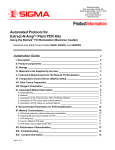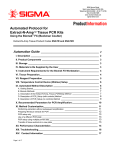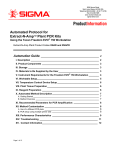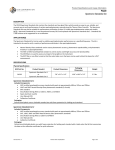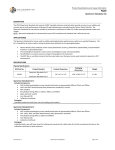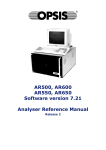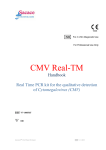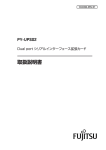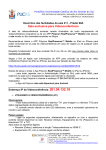Download Automated Protocol for Extract-N-Amp™ Plant PCR - Sigma
Transcript
Automated Protocol for Extract-N-Amp Plant PCR Kits Using the Sciclone ALH 3000 Workstation (Caliper Life Sciences) Extract-N-Amp Plant Product Codes XNAR, XNAPR, and XNAPRG Automation Guide ______________________________________________ 2 I. Description ______________________________________________________ 2 II. Product Components _____________________________________________ 3 III. Storage ________________________________________________________ 3 IV. Materials to Be Supplied by the User ________________________________ 3 V. Instrument Requirements for the Sciclone ALH 3000 Workstation ________ 4 VI. Deck Layout ____________________________________________________ 4 VII. Setup of Temperature Control Device_______________________________ 5 VIII. Plant Tissue Preparation _________________________________________ 5 IX. Reagent Preparation _____________________________________________ 5 X. Automated Method Description_____________________________________ A. Getting Started ___________________________________________________ B. Methods ________________________________________________________ C. Method Overview: Main_Extract-N-Amp_Plant ______________________________ D. Method Overview: SUB_PCR_Setup _____________________________________ 6 6 6 6 7 XI. Recommended Parameters for PCR Amplification: ____________________ 7 XII. Method Customization ___________________________________________ A. PCR setup only ___________________________________________________ B. Use of a different PCR plate ___________________________________________ C. PCR setup using multiple primer sets _____________________________________ 7 7 7 7 XIII. Performance Characteristics _____________________________________ 7 XIV. Troubleshooting _______________________________________________ 9 XV. Contact Information____________________________________________ 11 Page 1 of 11 Automation Guide I. Description The Extract-N-Amp Plant PCR Kits (Product Codes XNAR, XNAPR, and XNAPRG) have been developed for use as a high-throughput system for the rapid extraction and subsequent amplification of genomic DNA from various plant leaves in a 96-well format. The Extract-N-Amp Plant PCR Kits provide a novel extraction system that eliminates the need for long enzymatic digestions and homogenization steps that are not amenable to automation. The XNAR Kit includes a specially formulated Extract-N-Amp PCR ReadyMix reagent that is a 2x reaction mixture of buffer, salts, dNTPs, and Taq polymerase. The ReadyMix reagent also contains Sigma’s antibody mediated hot start mechanism, JumpStart Taq polymerase, for highly specific amplification of genomic DNA directly from the extract. The XNAPR Kit includes the REDExtract-N-Amp PCR ReadyMix reagent containing an inert tracking dye for convenient direct loading of PCR reactions onto agarose gels for analysis. The XNAPRG Kit includes a SYBR Green Extract-N-Amp PCR ReadyMix reagent for real-time quantitative analysis of the amplified PCR products. The validated method created for use on the Sciclone ALH 3000 Liquid Handling Workstation from Caliper Life Sciences provides a walk-away protocol for all aspects of the Extract-N-Amp Plant PCR kit. Extraction and amplification of genomic DNA from plant leaves is accomplished in 4 easy steps: 1. The Extraction Solution is added to a piece of leaf tissue. 2. Extracts are incubated for 10 minutes at 85 °C. 3. The Dilution Solution is added to the extract. Extracts are now stable for at least 6 months if stored at 2−8 °C. 4. PCR reactions are set up using 4 µl of the extracts. In just 30 minutes, the Sciclone ALH 3000 can complete extraction and PCR reaction setup for 96 leaf tissue samples. Page 2 of 11 II. Product Components Product Code Extract-N-Amp Plant XNAR REDExtract-N-Amp Plant XNAPR SYBR Green Extract-N-Amp Plant XNAPRG Package Size 1,000 extractions 1,000 amplifications 1,000 extractions 1,000 amplifications 1,000 extractions 1,000 amplifications Extraction Solution E7526 120 ml 120 ml 120 ml Dilution Solution D5688 120 ml 120 ml 120 ml Extract-N-Amp PCR Ready Mix or SYBR Green Extract-N-Amp PCR Ready Mix E3004 (for XNAR) R4775 (for XNAPR) S4320 (for XNAPRG) 12 ml 12 ml 12 ml Reagents Provided III. Storage The Extract-N-Amp Plant PCR Kits can be stored at 2−8 °C for up to 3 weeks. For long-term storage, store at –20 °C. Do not store in a frost-free freezer. IV. Materials to Be Supplied by the User 1. 2. 3. 4. 5. 6. 7. 8. 9. 10. 11. 12. 13. 14. 15. 16. 17. 18. 19. 20. Plant leaf tissues Paper punch (standard one-hole) Forceps (small to medium in size) Primers for plant genes of interest (Optional) GenElute Plant Genomic DNA Miniprep Kit (Sigma, G2N10, G2N70, and G2N250) for use as genomic DNA control. Water, molecular biology reagent (Sigma, W4502) 96-well PCR plates, with full skirt (Sigma, P4616) 96-well PCR plates, with half skirt (ABgene, AB-1100) Lid, universal (Fisher, 07200694) Ultra clear cap strip (ABgene, AB-0866) Corning plate holder (Corning, 6525) Sealing film, SealPlate (Sigma, Z369659) Microcentrifuge tubes (1.5 ml, 2 ml screw cap) 24-position Eppendorf IsoTherm System (Fisher, 05-405-22) 12-column reagent reservoir with low profile (Innovative Microplates, S30028) 96-well reservoir with low profile and pyramidal bottom (Innovative Microplates, S30018) (Optional) 12-column reagent reservoir with high profile (Innovative Microplates, S30019) (Optional) 96-well reservoir with high profile and pyramidal bottom (Innovative Microplates, S30014) Thermal Cycler Thermometer (Fisher, 15-077-26) Page 3 of 11 V. Instrument Requirements for the Sciclone ALH 3000 Workstation Part Description Deck Mounted Shaker High Temperature Control Device 96-well PCR Plate Adapter for Use with Temperature Control Device 96-channel High Volume Head Z8 Pipettor Gripper I/O Box Deck Locator Tip Box Locator 100 µl Disposable Tip Box 80 µl Barrier Tip Box 200 µl Disposable Tip Box Qty 1 1 1 Ordering Information Contact Caliper Contact Caliper Contact Caliper 1 1 1 1 7 4 2 2 1 Contact Caliper Contact Caliper Contact Caliper Contact Caliper Contact Caliper # 76523 (Caliper) # 66670 (Caliper) # 68759 (Caliper) # 56362 (Caliper) VI. Deck Layout Deck Position B2 100 µl Tip box Lid position for tissue sample plate B3 80 µl Tip box, Barrier Tips B4 80 µl Tip box, Barrier Tips C2 96-well PCR plate with full skirt containing tissue samples (with Lid) C3 96-well PCR plate with half skirt for PCR reaction setup (seated into a plate holder) C4 24 position Eppendorf IsoTherm system C5 PCR plate adapter for temperature control device D1 100 µl Tip box D2 96-well reservoir for Dilution Solution B1 Page 4 of 11 Equipment D3 12-column reservoir for PCR master mix D4 96-well reservoir for the Extraction Solution D5 Shaker VII. Setup of Temperature Control Device Set the temperature control device to the maximum setting of 110 °C with an offset of –4 °C (refer to the Watlow Temperature Control device User’s Manual). Place a PCR plate containing 100 µl of water in each well on the device and measure the temperature inside the wells using thermometer probes. Verify that the temperature in the wells is at a minimum of 85 °C after 3 minutes. Approximately one hour prior to running the automated method, turn on the temperature control device and verify that the temperature display on the controller has reached the desired reading. VIII. Plant Tissue Preparation 1. Rinse the paper punch and forceps in 70% ethanol prior to use and between different samples. Punch a 0.5−0.7 cm disk of leaf tissue into a 96-well PCR plate with full skirt ensuring that each sample is centered down into the bottom of each well. 2. Chill the plate at 2−8 °C until needed. IX. Reagent Preparation 1. Extraction Solution To process a single plate of 96 samples, add 15 ml of the solution to the 96-well reservoir located at position D4. If it is desired to process more than 12 plates of samples, the high-profile reservoir (S30014) is required. 2. Dilution Solution To process a single plate of 96 samples, add 15 ml of the solution to 96-well reservoir located at position D2. If it is desired to process more than 12 plates of samples, the high-profile reservoir (S30014) is required. 3. PCR Master Mix All Extract-N-Amp Plant PCR ReadyMixes are formulated as a 2X reaction mixture containing buffer, salts, dNTPs, and Taq polymerase. To prepare a PCR master mix, add water and the forward and reverse primers to the Extract-N-Amp Plant PCR ReadyMixes as described in the table below. Stock Water PCR ReadyMix (E3004, R4775 or S4320) Forward Primer (100 µM) Reverse Primer (100 µM) PCR Master Mix (2.4 ml) 0.9 ml 1.5 ml 12 µl 12 µl To set up 20 µl PCR reactions in one 96-well plate, a total of 2.4 ml of PCR master mix needs to be added to the second column of the reservoir located at position D3. If setting up more than 3 plates of samples for PCR, it will be necessary to use reservoir S30019. 4. No-template Control (optional) Add water into four 2 ml screw cap tubes and place in column 5 of the 24-position tube rack located at position C4. 5. DNA Controls (optional) Prepare genomic DNA controls for quantification of the plant tissue DNA extracts. Genomic DNA from leaf tissues were prepared using GenElute Plant Genomic DNA Miniprep Kit and placed in column 4 of 24-position tube rack located at position C4. Page 5 of 11 X. Automated Method Description This overview describes the general liquid handling steps required to execute the automated Extract-N-Amp Plant PCR method and can be customized to a variety of applications. For custom applications see Section XII. A. Getting Started 1. Turn on temperature control device. 2. Turn the plate shaker module controller clockwise a third past the first black line. If using the Teleshake v1.2 software, use a setting of 750 rpm. 3. Set up the deck layout by placing the tip boxes, plates, tube racks and reservoirs at the appropriate positions on the deck as described in section VI. 4. Add reagents to the appropriate reservoirs as described in section IX. 5. Run the method using Sciclone Software Version 3.2. 6. At the completion of the method, place cap strips onto the PCR plate, vortex to mix the solution and briefly centrifuge. The PCR plate is now ready to be placed into a thermal cycler. 7. Seal the PCR plate containing plant tissue extracts with a sealing film. Plant tissue extracts can be stored for up to 6 months at 2−8 °C. B. Methods Five methods have been created for this application: 1. MAIN_Extract-N-Amp_Plant: Performs all of the steps necessary to extract DNA from 96 leaf tissue samples and set up PCR reactions. 2. SUB_PCR_Setup: This sub-routine is called up in the main method to perform PCR reaction setup for 96 samples using a master mix. This method may be used if it is desired to perform additional amplification experiments from leaf tissue extracts. 3. SUB_TipTouch (PCRMix): This sub-routine is called up in the main method to perform the tip touching steps after aspirating the PCR master mix from the 12-column reagent reservoir. This method must be modified if using a different trough for the PCR master mix. 4. SUB_TipTouch (DNAExtract): This sub-routine is called up in the main method to perform the tip touching steps after dispensing the DNA extracts into the PCR reaction plate. This method may be modified if a different PCR plate is used. 5. SUB_TipTouch (DNAControl): This sub-routine is called up in the main method to perform the tip touching steps after aspirating the DNA controls from the 2-ml screw cap tubes. This method may be modified if a different sized tube for DNA controls is used. C. Method Overview: Main_Extract-N-Amp_Plant Below is a summary of the method, Main_Extract-N-Amp_Plant. For complete program details the automation program can be downloaded at www.sigmaaldrich.com/automation: 1. The extraction solution (50 µl) is dispensed into a multiwell plate containing plant tissue samples using the 96-channel head. 2. The plate is moved to the shaker and mixed for 30 seconds. 3. The plate is moved to the temperature control device and incubated at 85 °C for 10 minutes. 4. The dilution solution (50 µl) is dispensed into the plate containing the extracts. 5. Using the 96-channel head, samples are mixed for 8 cycles. 6. The plate is moved to the shaker and mixed for 30 seconds. 7. A command calls up and performs all steps of the Sub_PCR_Setup Method. The overview of this method is listed below. Page 6 of 11 D. Method Overview: SUB_PCR_Setup Below is a summary of the method, SUB_PCR_Setup. For complete program details the automation program can be downloaded at www.sigmaaldrich.com/automation: 1. PCR master mix (16 µl) is multi-dispensed to the PCR amplification plate using the Z-8 head. 2. Tissue extract (4 µl) is dispensed into the PCR amplification plate. 3. Control DNA samples (4 µl) and water (negative control, 4 µl) are dispensed into eight wells of column 12 of the PCR amplification plate using the Z-8 dispense head. XI. Recommended Parameters for PCR Amplification: Step Temperature Time Initial Denaturation 94−96 °C 3 minutes Denaturation 94−96 °C 0.5−1 minutes Annealing 45−68 °C 0.5−1 minutes Extension 72 °C 1−2 minutes (~1 kb/min) Final Extension 72 °C 10 minutes Hold 4 °C Indefinitely Cycles 1 30−40 1 XII. Method Customization A. PCR setup only Leaf tissue extracts may be subjected to additional amplifications. The SUB_PCR_Setup method described in Section X may be used for this purpose. B. Use of a different PCR plate The automated method was created using the 96-well PCR amplification plates with half skirt from ABgene. Other PCR plates may be used in this method, but may require the creation of a new labware in the Sciclone software. If a different PCR plate is used, the SUB_TipTouch (DNAExtract) method may need to be adjusted. This tip touching is a critical step for the addition of the low volume of leaf tissue DNA extract to the reaction mixture. C. PCR setup using multiple primer sets To amplify genomic DNA from the 96 leaf tissue extracts with different primer sets, primers can be added to microfuge tubes and placed on the 24-position tube racks. Additional steps will need to be added to the PCR_Setup method to account for the primer addition. Page 7 of 11 III. Performance Characteristics PCR Analysis of Corn Leaf Tissue Samples M 1 2 3 4 5 6 7 8 9 10 11 + M 1 2 3 4 5 6 7 8 9 10 11 - M A B Universal C D Universal Chloroplast (438bp) Chloroplast (438bp) E F G H Universal Chloroplast (438bp) Universal Chloroplast (438bp) Figure 1. DNA was extracted from 88 maize leaf samples. Amplification of the 438 bp fragment of universal chloroplast genomic DNA is indicated by the arrow. M: PCR marker. (+): Maize genomic DNA control. (-): No DNA template control. PCR Analysis of Different Plant Types M A 1 2 3 4 5 6 7 8 9 10 11 + M 1 2 3 4 5 6 7 8 9 10 11 - M B Universal Chloroplast C D Universal Chloroplast Figure 2. DNA was extracted from soybean, tobacco, tomato, and maize leaves. Amplification of the 400−500 bp fragment of universal chloroplast genomic DNA is indicated by the arrow. Soybean samples are in lanes A1-A11, tobacco samples are in lanes B1-B11, tomato samples are in lanes C1-C11, and maize samples are in lanes D1-D11. M: PCR marker. (+): Maize genomic DNA control. (-): No DNA template control. Page 8 of 11 Cross-contamination Analysis M 1 2 3 4 5 6 7 8 9 10 11 12 M 1 2 3 4 5 6 7 8 9 10 11 12 M A B C D E F G H Universal Chloroplast (438bp) Universal Chloroplast (438bp) Universal Chloroplast (438bp) Universal Chloroplast (438bp) Figure 3. 0.5−0.7 cm disks of corn leaves were placed in alternating wells of the Extraction plate. The 96-well plate was processed using the automated Extract-N-Amp Plant PCR procedure on the Sciclone ALH 3000. All samples were then subjected to amplification and 6 µl of the resultant products were electrophoresed on a 2% Agarose gel. PCR products were not detected in the wells without plant tissue samples. Quantitative PCR Analysis Figure 4. Eighty-eight tomato leaf samples were extracted using the SYBR Green Extract-N-Amp Plant PCR Kit following the automated procedures. Reaction analyses were performed on an ABI Prism 7700 Sequence Detection System. The graph was plotted as the intensity of florescence in logarithms versus the value of cycle threshold (CT). XIV. Troubleshooting Page 9 of 11 Problem Cause Solution Little or no PCR product is detected. A PCR component is missing or degraded. Run a positive control to ensure components are functioning. No leaf tissue extract is added to the PCR reactions. Check the performance of liquid handler. Prime the system if needed. Increase the tip travel distance inside well in the step of aspirating tissue extract from the extraction plate. PCR reaction is inhibited due to contaminants in leaf tissue extract. Use less extract or dilute the extract with 50:50 mix of Extraction and Dilution Solutions and repeat PCR. The mixing of Dilution Solution with leaf tissue DNA extract is not sufficient due to inefficient mixing by the liquid handler and/or the clogging of the pipette tip by the tissue. Increase the aspiration and dispensing speed and/or cycle times in the mixing steps. Decrease the tip travel distance inside well in the mixing steps to avoid sucking up the tissue by the pipettors. Genomic DNA is sheared when mix the solution with the pipettor. Reduce the aspiration and dispensing speed and/or cycle times in the mixing steps. It is critical for amplifying the large genomic DNA fragments. Too few cycles are performed. Increase the number of cycles (5−10 additional cycles at a time). Others Refer to the Technical Bulletin of Extract-N-Amp Plant PCR Kits. Reagents are contaminated. Use new labware and new batch of reagents. Test a reagent blank without DNA template to determine if the reagents used in extraction or PCR are contaminated. Negative control shows a PCR product or “false positive” results are obtained. Page 10 of 11 XV. Contact Information Technical Service Help (800) 325-5832 email: [email protected] Customer Service Help (800) 325-3010 (800) 588-9160 www.sigma-aldrich.com/order This product is sold under license from Roche Molecular Systems, Inc. and Applied Biosystems. Taq Antibody licensed for in vitro research use under U.S. Patent No. 5,338,671 and 5,587,287, and corresponding patents in other countries. Eppendorf is a registered trademark of Eppendorf-Netheler-Hinz GmbH Z8 is a trademark of Caliper Life Sciences, Inc. JV,KTA 10/05-1 Sigma brand products are sold through Sigma-Aldrich, Inc. Sigma-Aldrich, Inc. warrants that its products conform to the information contained in this and other Sigma-Aldrich publications. Purchaser must determine the suitability of the product(s) for their particular use. Additional terms and conditions may apply. Please see reverse side of the invoice or packing slip. Page 11 of 11











